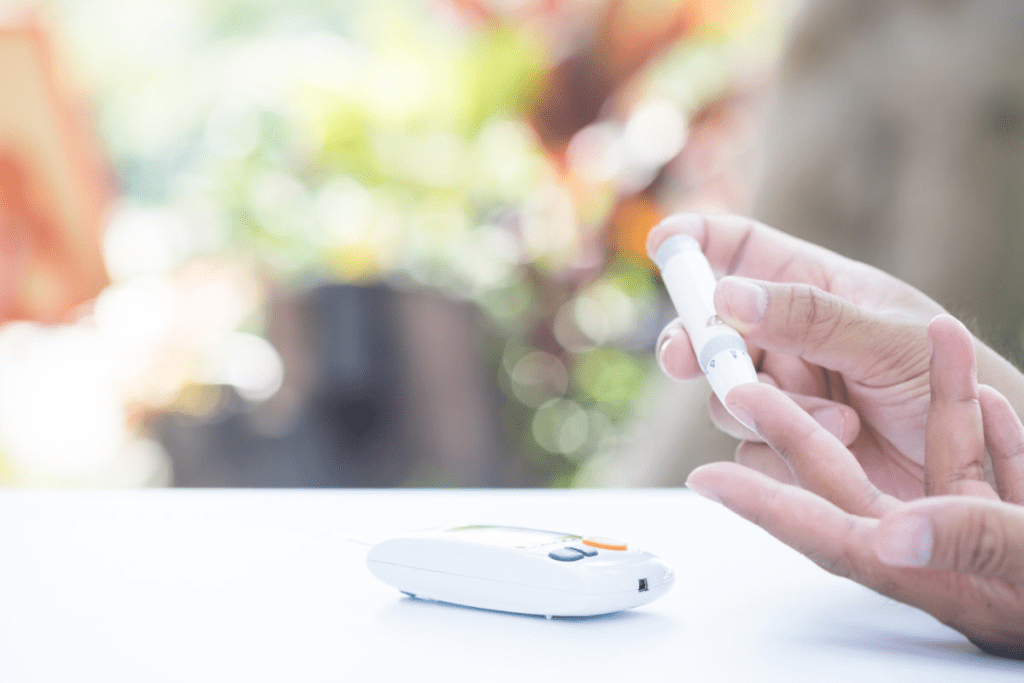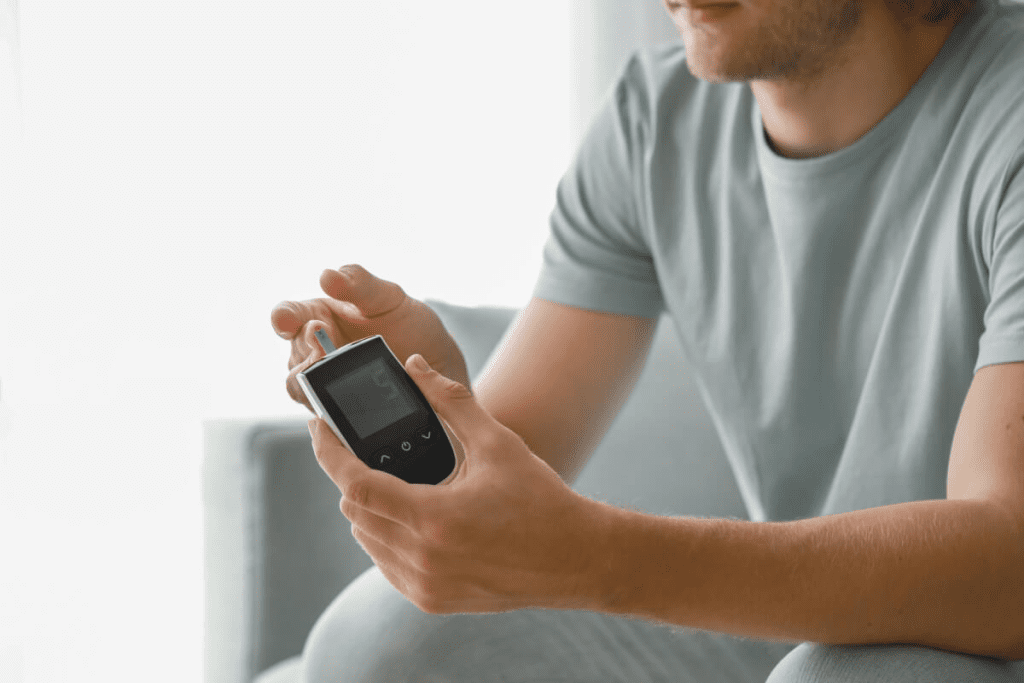Last Updated on November 14, 2025 by
Checking a child for diabetes at home can be tough for parents. But, with the right tools and knowledge, it’s doable. A home blood glucose meter is a common tool for checking blood sugar levels.
Recent studies show that some meters, like the One Touch Ultra, match lab standards well. They have a median absolute difference of about 5-6%. Also, 94-99% of their readings meet ISO accuracy criteria. This means parents can trust the data to make good decisions.

By learning how to use these meters and understand the results, parents can help monitor their child’s health. We’ll talk about why it’s important to pick a reliable home blood glucose meter. We’ll also give tips on how to do that. fasting blood sugar 20 months old may show signs of diabetes. Learn safe at-home checks and when to consult your doctor.
It’s important to know the signs of diabetes in kids early. Type 1 diabetes can start suddenly. So, parents and caregivers need to watch for any unusual signs.

Children with diabetes might show some physical signs. These include:
These signs point to high blood sugar levels, a key sign of diabetes. If you see these signs, see a doctor right away.
Type 1 diabetes can also change a child’s behaviour. Look out for:
Knowing these type 1 diabetes child behaviour changes can help spot the condition early. For more on early signs of diabetes, check out Summa Health’s article.
Some diabetes symptoms can be handled at home. But some need immediate medical help. If your child has:
Call for emergency care right away. These signs can mean a serious problem like diabetic ketoacidosis.
For parents of kids with diabetes, checking fasting blood sugar levels is key. It shows how their body reacts to food, exercise, and medicine. Regular checks help parents make better care choices for their child.

Getting your child ready for a blood test can ease the stress. Explain it in a way they can get. Show them on a doll or teddy bear to make it less scary. On test day, keep them comfy and distracted.
Using a home blood glucose meter requires a clear plan for the right results. First, clean your hands before touching the meter and strips. Then, put a strip in the meter and follow the maker’s guide to set it up. Next, use a lancet to get a blood sample from your child’s finger. After that, put the blood on the strip, and the meter will show the sugar level.
To make blood tests less scary for kids, create a supportive space. Try to make it quick and painless. Use thin lancets to lessen the pain. Praise your child and give small rewards for good tests. Let them help, like picking the finger or using the meter.
By following these tips, parents can make checking fasting blood sugar easier and less stressful. Knowing the normal blood sugar level in infants and the normal infant blood sugar range helps understand test results better.
Managing diabetes in kids is all about picking the right tools. Parents need to find meters and monitors that are easy to use and give accurate readings. This ensures kids get the care they need, when they need it.
Home meters are key for diabetes care, giving quick info on blood sugar levels. When picking a meter for kids, look for ease of use and small blood sample needs. Also, features like storing data and calculating insulin doses are a plus.
Here are some top meters for kids:
CGMs are a step up in diabetes care, giving constant glucose data day and night. They help spot trends and patterns, guiding decisions on diet, exercise, and insulin.
Here are some top CGMs for kids:
Non-fasting tests are useful for diabetes detection, too. They’re great for kids because they don’t need to fast beforehand. This makes the test less stressful for them.
Here are some non-fasting tests for diabetes:
Knowing the normal blood sugar levels in children is key for parents and caregivers. It helps keep their young ones healthy. Blood sugar levels change with age, so it’s important to know the right range for each age group.
Newborns and infants have a normal blood sugar range of 30 to 50 mg/dL in the first days. This range increases as they grow. It’s important to remember that these levels can change, even in the first days after birth.
Key considerations for newborns and infants include:
For toddlers (1-3 years), normal blood sugar levels are between 70 to 100 mg/dL when fasting. These levels can change based on diet and how active they are.
Factors affecting blood sugar in toddlers include:
As children get older, their normal blood sugar levels change. A fasting blood glucose level under 100 mg/dL is normal. Levels between 100 mg/dL and 125 mg/dL might mean they’re at risk for diabetes. Levels over 126 mg/dL could mean they have diabetes.
Understanding these ranges is key for:
Many things can change blood sugar readings in children, like being sick, taking certain medicines, or feeling stressed. It’s also important to think about when they last ate when checking their blood sugar.
Tips for managing these factors include:
Working with your child’s doctor is key to managing diabetes in kids. A diabetes monitoring plan helps track your child’s blood sugar levels. This way, you can make changes as needed. We will work with your child’s healthcare provider to make a plan that fits your child.
Managing diabetes in children needs a full approach. Your child’s doctor will teach you about the normal blood sugar range for their age. This includes the newborn’s normal blood sugar level. Knowing this is important for a good diabetes monitoring plan.
By following the advice in this article and working with your child’s doctor, you can help your child manage their diabetes. A good diabetes monitoring plan is essential for keeping your child healthy.
Normal blood sugar levels in infants change with age. Newborns need a level above 45 mg/dL. Infants and toddlers should have levels between 70-100 mg/dL when fasting. After meals, it should be below 180 mg/dL.
Look for a meter that’s easy to use and accurate. Also, check if it needs a small blood sample. Always talk to your child’s doctor for the best meter for them.
Signs of diabetes include being very thirsty and urinating a lot. Your child might also feel tired, have blurry vision, or lose weight without trying. Mood swings can also be a sign.
Explain the test in a way your child can understand. Tell them it’s quick and not very painful. You can practice with a dummy or a small prick to make them feel more at ease.
Tests include the random plasma glucose test and the OGTT with a non-fasting sample. Your child’s doctor will decide which test is best for them.
Monitoring frequency depends on your child’s needs and treatment plan. Kids with diabetes usually need to check their levels many times a day. Your child’s doctor will guide you on how often to check.
Several things can change blood sugar readings, like what your child eats and drinks, their activity level, and some medicines. Mistakes with the meter, like not calibrating it correctly or using old test strips, can also affect readings.
CGMs can help manage diabetes in kids. But you should talk to your child’s doctor first. They can help decide if a CGM is right for your child and how to use it.
Subscribe to our e-newsletter to stay informed about the latest innovations in the world of health and exclusive offers!